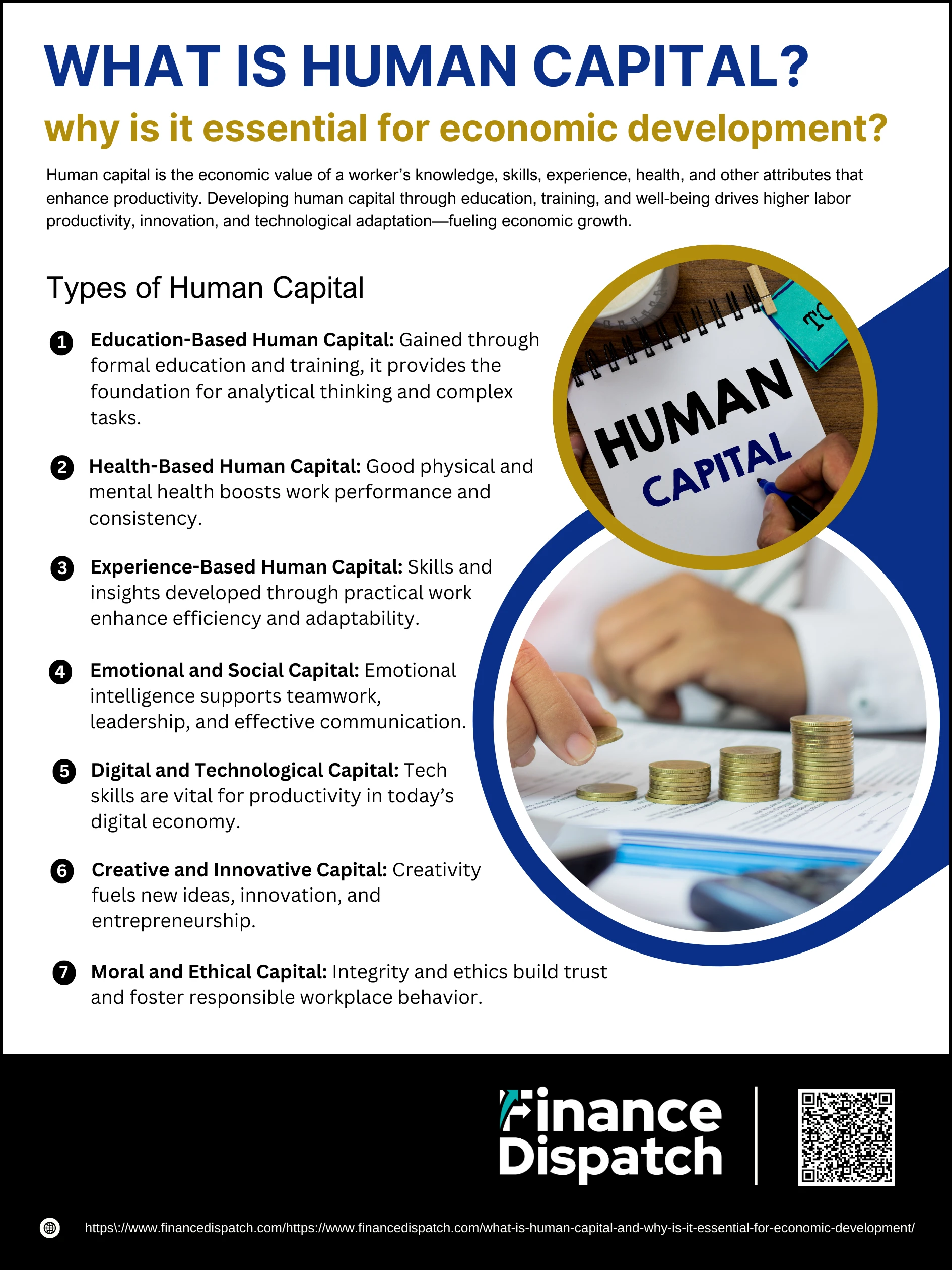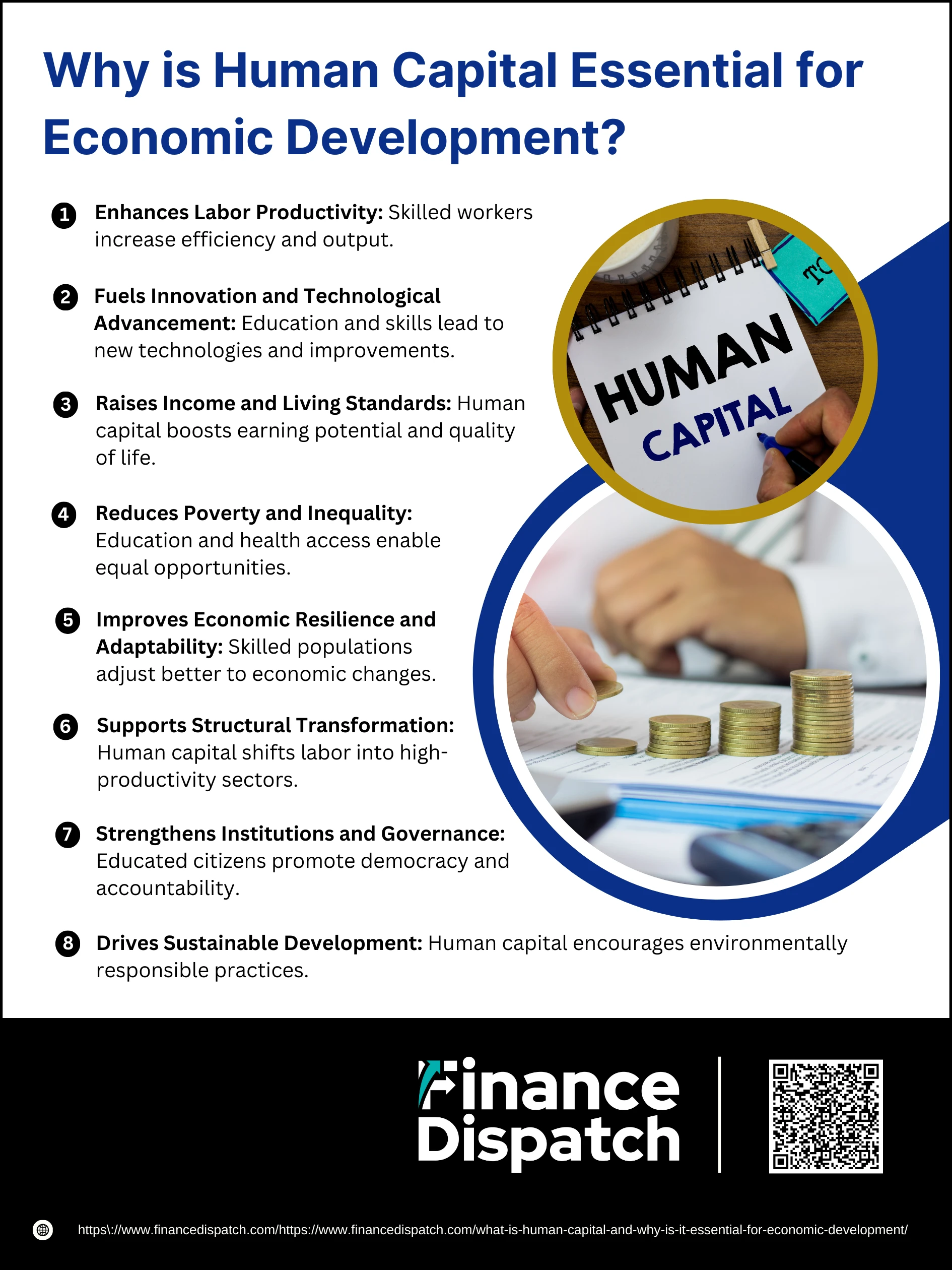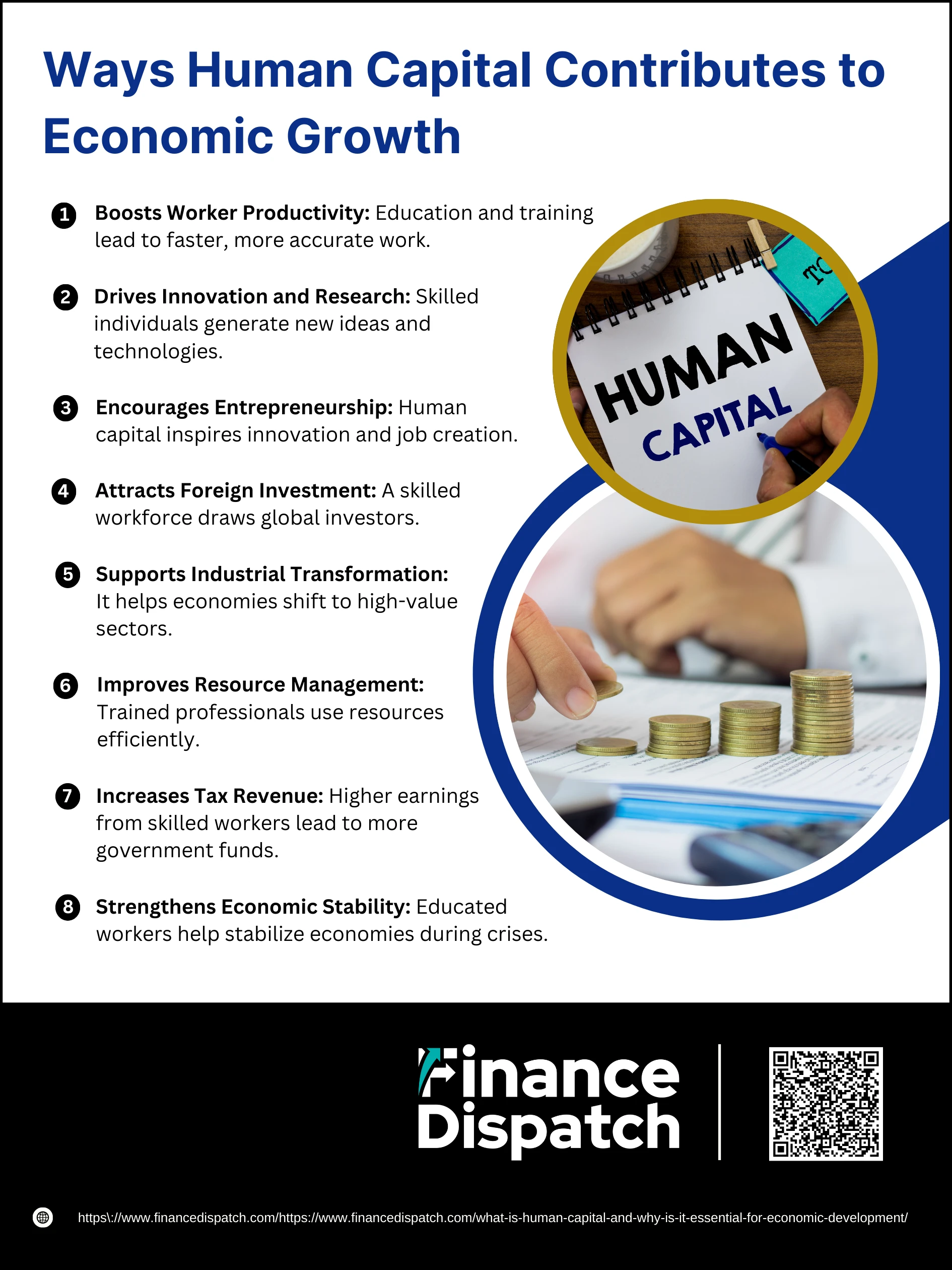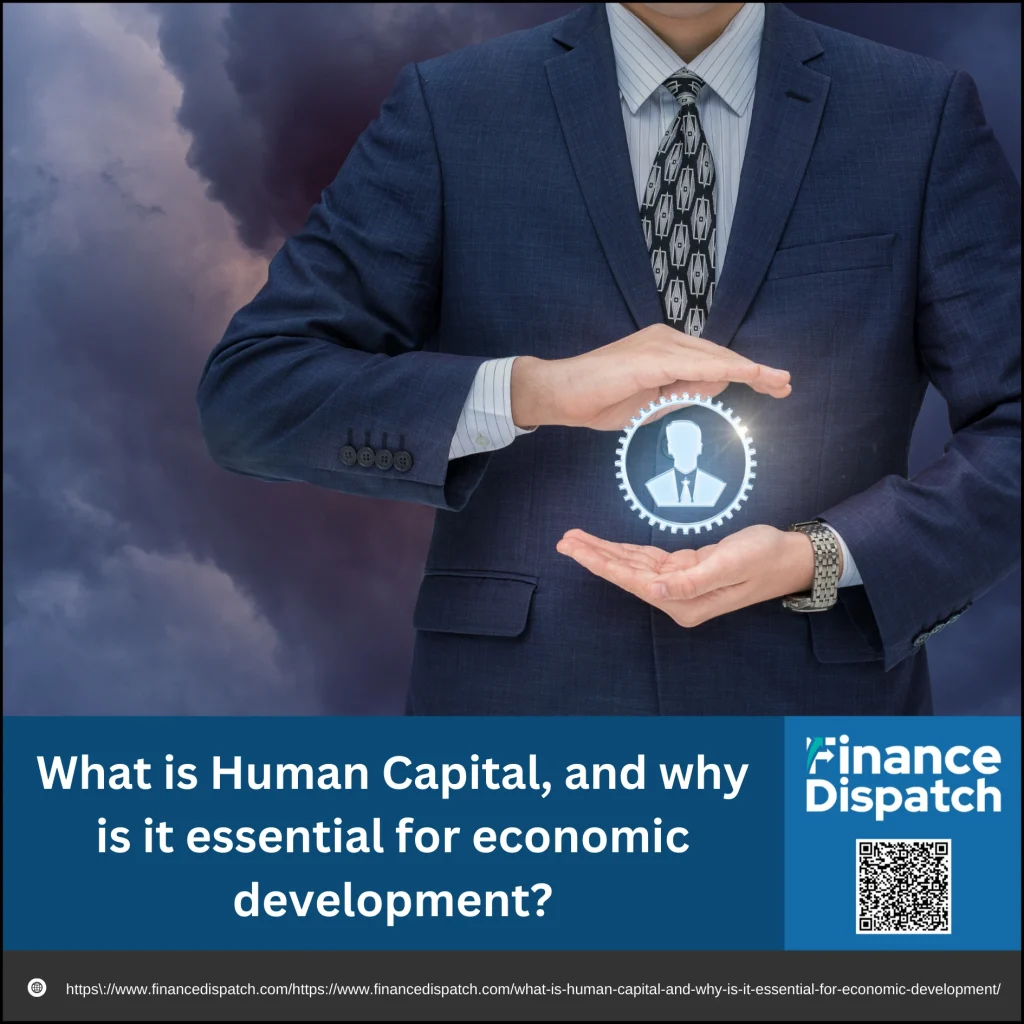In today’s rapidly evolving global economy, the most valuable asset a nation possesses isn’t its natural resources or infrastructure—it’s its people. The skills, knowledge, health, and experience that individuals bring to the workforce form what economists call human capital. Unlike physical or financial capital, human capital is intangible but deeply influential. It powers innovation, boo sts productivity, and drives long-term economic growth. As economies shift from manufacturing-based to knowledge-driven systems, investing in human capital has become not just beneficial, but essential. Understanding what human capital is—and why it matters—is the first step toward building a more resilient, equitable, and prosperous society.
What is Human Capital?
Human capital refers to the economic value of the knowledge, skills, experience, health, and attributes possessed by individuals that contribute to their productivity in the workforce. It encompasses both innate qualities and those acquired through education, training, and personal development. Unlike physical assets, human capital is intangible and cannot be listed on a company’s balance sheet, yet it plays a crucial role in shaping organizational success and national economic performance. When individuals are well-educated, healthy, and skilled, they are better equipped to innovate, solve problems, and adapt to technological changes—making them vital contributors to economic growth and societal progress.
Key Components of Human Capital
Human capital is not a single attribute but a combination of several interconnected factors that determine an individual’s economic value and contribution to productivity. These components help shape a person’s ability to perform effectively in the workforce, adapt to changes, and drive innovation within organizations and economies.
Key components include:
1. Education and Knowledge – Formal education, literacy, and domain-specific expertise acquired through schools, colleges, and training programs.
2. Skills and Competencies – Practical and technical skills, including digital literacy, problem-solving, and communication abilities, that enhance job performance.
3. Experience – Insights and abilities developed through years of work, internships, or apprenticeships, often tailored to specific industries.
4. Health and Well-being – Physical and mental health that supports consistent performance and reduces absenteeism.
5. Emotional Intelligence – The ability to manage emotions, work under pressure, and collaborate effectively in teams.
6. Work Ethic and Attitude – Reliability, motivation, and professionalism that influence an individual’s approach to tasks and responsibilities.
7. Adaptability and Lifelong Learning – The willingness and ability to continuously learn new skills and respond to technological and market changes.
8. Creativity and Innovation – The capacity to generate new ideas, improve existing processes, and contribute to organizational growth.
 Types of Human Capital
Types of Human Capital
Human capital is a broad and multifaceted concept, encompassing more than just education or work experience. It includes a range of qualities that influence how individuals perform in their roles and contribute to both organizational success and economic development. By categorizing human capital into distinct types, we can better understand how people acquire value, adapt to change, and generate innovation across various sectors of society.
Here are the main types of human capital explained in detail:
1. Education-Based Human Capital
This type includes the knowledge and intellectual skills gained through formal education—primary, secondary, and higher learning—as well as vocational training and certifications. It forms the cognitive foundation necessary for analyzing information, solving problems, and performing complex tasks in the modern workforce.
2. Health-Based Human Capital
A person’s physical and mental health significantly impacts their productivity. Healthy individuals are more likely to attend work consistently, maintain focus, and work longer hours over their lifetime. Investments in nutrition, healthcare access, and mental wellness directly strengthen this type of human capital.
3. Experience-Based Human Capital
Acquired through years of practical work, this type includes job-specific knowledge, decision-making abilities, and process optimization skills developed on the job. Experience not only improves efficiency but also helps individuals mentor others and adapt quickly in dynamic industries.
4. Emotional and Social Capital
These are the interpersonal traits that enable individuals to communicate clearly, resolve conflicts, collaborate effectively, and show empathy. High emotional intelligence is especially valuable in leadership, management, and team-based roles.
5. Digital and Technological Capital
In the digital era, tech proficiency is essential. This type of human capital includes familiarity with digital tools, software, data analysis, online communication platforms, and the ability to adapt to emerging technologies—skills that are increasingly demanded across all industries.
6. Creative and Innovative Capital
Creativity fuels innovation. This type includes the capacity to generate novel ideas, think critically, and solve unique problems. It plays a central role in entrepreneurship, product development, and process improvement.
7. Moral and Ethical Capital
Ethics, integrity, and a sense of social responsibility are important for building trust in workplaces and societies. This type reflects a person’s ability to make principled decisions, uphold fairness, and contribute positively to an organization’s culture and reputation.
 Why is Human Capital Essential for Economic Development?
Why is Human Capital Essential for Economic Development?
In an increasingly knowledge-based global economy, human capital has emerged as the cornerstone of economic development. It refers to the collective abilities, skills, health, and knowledge possessed by individuals that enable them to contribute meaningfully to productive activities. Unlike natural resources or machinery, human capital has the unique ability to innovate, adapt, and grow continuously. Countries that invest in developing their people through education, healthcare, and skill-building tend to achieve faster, more inclusive, and more sustainable economic growth. Without strong human capital, even the most resource-rich nations may struggle to reach their development potential.
Here are key reasons why human capital is essential for economic development:
1. Enhances Labor Productivity
Skilled and educated workers are more capable of performing tasks efficiently and accurately. This leads to higher output per worker, better use of resources, and stronger economic performance across sectors.
2. Fuels Innovation and Technological Advancement
Human capital is the driver of innovation. Highly educated individuals contribute to research and development, create new technologies, and improve production methods, giving economies a competitive edge.
3. Raises Income and Living Standards
As people acquire education and professional experience, their earning potential increases. Higher income allows individuals to improve their standard of living, while also increasing their purchasing power—boosting consumer demand and business growth.
4. Reduces Poverty and Inequality
Access to quality education and health services enables more people—especially those in marginalized communities—to acquire the skills needed for decent employment. This helps break the cycle of poverty and reduce income inequality.
5. Improves Economic Resilience and Adaptability
A well-educated and healthy population can respond more effectively to economic shocks, technological disruptions, and labor market changes. This adaptability enhances the stability and sustainability of economic development.
6. Supports Structural Transformation
Human capital development helps shift labor from low-productivity sectors like traditional agriculture to higher-productivity sectors such as manufacturing, services, and technology. This transformation is essential for long-term economic growth.
7. Strengthens Institutions and Governance
Educated citizens are more likely to demand accountability, participate in democratic governance, and contribute to nation-building efforts. This improves political stability and institutional quality—both vital for economic development.
8. Drives Sustainable Development
Human capital contributes to sustainability by fostering environmental awareness, promoting green technologies, and developing skills needed for the clean energy economy. Educated individuals are better equipped to make responsible decisions about resources and consumption.
 Ways Human Capital Contributes to Economic Growth
Ways Human Capital Contributes to Economic Growth
Human capital is one of the most powerful engines behind sustainable economic growth. It encompasses the education, skills, health, and experience of a population—attributes that directly affect how effectively individuals contribute to productive activities. Unlike machinery or infrastructure, human capital has the unique ability to continuously improve and adapt through learning, training, and innovation. When a nation invests in its people, it does more than just improve individual livelihoods—it stimulates broader economic development, strengthens resilience, and lays the groundwork for long-term prosperity.
Here are key ways human capital contributes to economic growth:
1. Boosts Worker Productivity
Well-educated and trained workers tend to complete tasks faster, make fewer errors, and adapt to new systems more easily. Higher productivity increases a country’s output without necessarily increasing input costs, leading to a more efficient and competitive economy.
2. Drives Innovation and Research
A knowledgeable workforce is essential for generating new ideas, advancing research, and adopting cutting-edge technologies. Innovations in science, technology, and business processes not only improve existing systems but also create entirely new industries and markets.
3. Encourages Entrepreneurship
Human capital equips individuals with the confidence and capability to identify opportunities and start businesses. Entrepreneurs play a critical role in job creation, service delivery, and introducing disruptive innovations that push economies forward.
4. Attracts Foreign Investment
Global investors look for countries with skilled, reliable, and adaptable workforces. A strong base of human capital reduces training costs, improves efficiency, and increases the chances of success for foreign enterprises—making such countries favorable investment destinations.
5. Supports Industrial Transformation
Developing human capital allows economies to shift from low-productivity sectors like subsistence farming to high-value sectors such as manufacturing, finance, information technology, and healthcare. This transformation is essential for moving up the economic value chain.
6. Improves Resource Management
Skilled professionals are better equipped to manage and optimize the use of resources—whether it’s financial planning, environmental conservation, or operational efficiency. Smart use of resources leads to sustainable growth with less waste and fewer losses.
7. Increases Tax Revenue
As workers become more skilled, they often earn higher wages. This translates to increased tax contributions, giving governments the financial capacity to invest in public goods such as infrastructure, education, and healthcare, further boosting development.
8. Strengthens Economic Stability
A well-developed human capital base enhances economic resilience. In times of crisis—such as global pandemics, recessions, or natural disasters—a skilled and educated workforce can pivot quickly, adopt new tools, and help stabilize the economy.
Challenges in Building Human Capital
While human capital is critical for economic growth, developing it effectively remains a complex and demanding task. Many nations—especially developing and underdeveloped ones—struggle with systemic barriers that limit access to quality education, healthcare, and employment opportunities. Even in advanced economies, rapid technological change and shifting labor market needs create new challenges. Addressing these obstacles is essential to unlocking the full potential of a population and ensuring long-term, inclusive development.
Major challenges in building human capital include:
1. Limited Access to Quality Education
In many regions, especially rural and low-income areas, schools lack trained teachers, learning materials, and infrastructure, preventing students from receiving a solid foundation.
2. Healthcare Inequality and Poor Infrastructure
Uneven access to healthcare services reduces life expectancy and productivity. Malnutrition, mental illness, and lack of preventive care all hinder human capital development.
3. Rapid Population Growth
In some developing countries, the population grows faster than the capacity to educate and employ people, straining education and healthcare systems.
4. Skill Mismatch and Outdated Curricula
Education systems often fail to align with industry needs, producing graduates who lack the practical skills needed in the modern job market.
5. Brain Drain
Talented individuals often migrate to wealthier nations for better opportunities, depriving their home countries of valuable human capital.
6. Unemployment and Underemployment
Even educated individuals may struggle to find meaningful work, leading to frustration, loss of skills over time, and reduced return on education investments.
7. Gender Inequality
In many parts of the world, women and girls face barriers to education and employment, limiting the overall development of human capital.
8. Inadequate Investment in Training and Lifelong Learning
Lack of access to continuous professional development makes it difficult for workers to adapt to changing technology and labor market demands.
9. Political Instability and Weak Institutions
Conflict, corruption, and weak governance undermine investments in education and health, slowing human capital progress.
10. Cultural and Social Barriers
Social norms, discrimination, and lack of awareness can prevent marginalized groups—including minorities, people with disabilities, and indigenous communities—from accessing development opportunities.
How Governments and Organizations Can Invest in Human Capital
Investing in human capital is one of the most effective strategies for promoting long-term economic growth, reducing inequality, and improving overall societal well-being. Both governments and organizations play a vital role in strengthening the skills, health, and productivity of individuals. By developing strategic policies and programs that support education, healthcare, training, and workplace development, they can unlock the full potential of their human resources and build a more resilient economy.
Key ways governments and organizations can invest in human capital include:
1. Expanding Access to Quality Education
Ensure universal access to primary, secondary, and higher education, with a focus on quality teaching, modern curricula, and inclusivity for all social groups.
2. Improving Healthcare Infrastructure
Invest in affordable and accessible healthcare services, including preventive care, maternal health, mental health support, and vaccination programs.
3. Promoting Vocational Training and Skill Development
Develop technical and vocational education programs that align with market demands and equip individuals with job-ready skills.
4. Supporting Lifelong Learning Opportunities
Encourage continuous skill enhancement through online learning platforms, adult education, and professional certifications to help workers stay competitive.
5. Providing Financial Support and Scholarships
Offer financial aid, subsidies, and scholarships to students and workers from low-income backgrounds to reduce economic barriers to education and training.
6. Creating Inclusive Employment Policies
Promote equal opportunities for women, minorities, and people with disabilities by implementing inclusive hiring, flexible work arrangements, and anti-discrimination policies.
7. Encouraging Public-Private Partnerships
Collaborate with private companies to design training programs, internship opportunities, and mentorship systems that enhance workforce readiness.
8. Investing in Early Childhood Development
Focus on early nutrition, education, and care during the critical early years of life to build a strong foundation for lifelong learning and health.
9. Strengthening Digital and Technological Skills
Support programs that improve digital literacy and prepare workers for emerging sectors such as information technology, AI, and renewable energy.
10. Monitoring and Evaluating Human Capital Investments
Establish systems to track the impact of human capital programs through metrics like educational outcomes, employment rates, and health indicators to ensure continuous improvement.
Real-World Examples of Human Capital Driving Growth
The impact of human capital on economic development is not just theoretical—it is clearly visible in the real-world success stories of countries and regions that have prioritized investments in education, healthcare, and workforce development. These examples show how focusing on people’s knowledge, skills, and well-being can lead to higher productivity, innovation, and national prosperity. From advanced economies to emerging markets, the strategic development of human capital has proven to be a powerful driver of growth.
Notable examples of human capital driving economic growth include:
1. Finland – Focused heavily on high-quality, equitable education and rigorous teacher training, which has led to outstanding academic performance and a skilled, innovation-driven workforce.
2. South Korea – Transformed from a low-income country into a global tech leader by investing in STEM education, vocational training, and R&D, creating a highly competitive and skilled labor force.
3. Germany – Known for its dual vocational training system, which integrates classroom instruction with hands-on apprenticeships, ensuring a steady pipeline of skilled workers for its manufacturing and engineering sectors.
4. United States (Silicon Valley) – A hub of innovation fueled by top-tier universities, a skilled tech workforce, and strong support for entrepreneurship, resulting in global leadership in software and digital industries.
5. Singapore – Prioritized workforce development and lifelong learning programs, allowing it to attract foreign investment and build a highly productive, knowledge-based economy.
6. Israel – Invested heavily in education and military-based tech training, fostering a culture of innovation and becoming a global leader in startups and R&D.
7. Sweden – Offers universal healthcare and education, supports work-life balance, and promotes gender equality, resulting in high labor participation and inclusive growth.
8. Canada – Combines immigration policies with investments in education and healthcare to build a diverse, well-educated workforce that supports stable and sustained economic growth.
9. Rwanda – Despite its past challenges, the country has invested in healthcare, gender equality, and digital literacy to build human capital and drive development in key sectors like ICT and tourism.
10. India (Bangalore) – Became a global IT services hub through investments in technical education and the growth of a skilled workforce, contributing significantly to the country’s GDP and global reputation.
Conclusion
Human capital stands at the core of economic development, shaping the ability of nations to innovate, grow, and compete in a rapidly changing global landscape. By investing in education, health, skills, and lifelong learning, governments and organizations can unlock the full potential of their people, leading to higher productivity, reduced inequality, and sustained economic resilience. While challenges remain—such as unequal access, skill mismatches, and brain drain—strategic and inclusive approaches to human capital development can transform these obstacles into opportunities. Ultimately, strengthening human capital is not just a policy choice—it is a long-term investment in a country’s prosperity and future.



